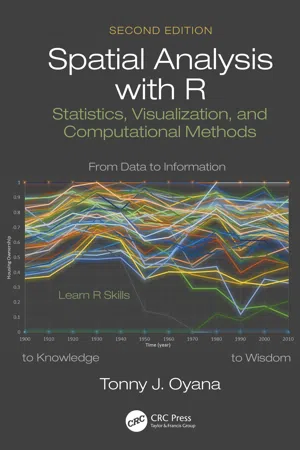1
Understanding the Context and Relevance of Spatial Analysis
Learning Objectives
1.Define and describe spatial analysis.
2.Describe the trends and significant developments in spatial analysis.
3.Define, describe, and illustrate key spatial concepts.
4.Learn about the unique properties of spatial data and inherent challenges.
Introduction
In conventional terms, geographers regard spatial analysis as a broad and comprehensive undertaking that entails the use of well-established analytical/visualization tools and procedures to analyze and synthesize locationally referenced data. These are formal techniques and analytical approaches for studying entities through their topological, geometric, or geographic properties. The approaches are rigorous and are drawn from statistical, mathematical, and geographic principles to conduct a systematic examination of spatial patterns and processes, including the exploration of interactions between space and time. Studying the locational and distributional arrangement of objects, people, events, and processes in space, and the underlying factors that account for these arrangements are some of the analytical goals of a geospatial data scientist. The work requires a place-based mindset with emphasis on uncovering spatial patterns and spatial linkages and examining spatial behaviors and complex interactions within and across locations that result in these distributional patterns.
Engaging in spatial analysis typically requires the use of quantitative data in a digital format, but increasingly data scientists are devising interesting and creative ways to integrate qualitative and contextual data into the analysis. Once a research project is defined with the articulation of a clear set of goals, objectives, and research questions, the data scientist begins by systematically choosing the appropriate units of observation from which to collect the data, the spatial scales at which they will be measured, and the variables and means by which the data values will be assigned to those variables.
The field of spatial analysis is inspired by a strong logical positivist tradition that involves inductive and deductive reasoning, hypothesis testing, and model building. It develops and advances geographic knowledge by investigating empirical events that occur in space, time, or both space and time. It consists of one or more of the following activities: (1) the analysis of numerical spatial data, (2) the development of spatial theory, and (3) the construction and testing of mathematical models of spatial processes (Fotheringham et al. 2000). Through spatial analysis, knowledge about spatial patterns and processes can be obtained, a large-scale dataset can be separated into several smaller components and meaningful information can be extracted, and a set of hypotheses can be derived and tested, thus culminating in empirical evidence. In addition, we can examine the role of randomness in generating observed spatial patterns of data, test hypotheses about such patterns, account for spatial variability, measure spatial autocorrelation and the underlying structure of the data, confirm the presence of outliers (if any), provide information about the explanatory factors or determinants through estimates of the model parameters, and provide a framework in which predictions can be made about the spatial impacts of various actions.
As an example, let us assume that you are working with a local food bank agency, and efforts are underway to develop urban community gardens, a new initiative deemed to be effective in combating food insecurity in urban areas. A lingering concern in the community is soil quality with the strong likelihood of environmental contaminants such as lead in the soil. To explore this, a sampling design strategy is formulated to collect soil samples. Using the Global Positioning System (GPS), a total of 150 samples are taken from various parts of the city. The samples are tested for lead contaminants along with other variables such as organic content, distance from major highways, soil moisture, alkalinity, and so on. The data are integrated into a geographic information system (GIS) with preexisting databases garnered through other devices such as land use and land cover maps from satellite imagery, housing quality data, roadways, and demographic data generated from the U.S. Census. As a geospatial data scientist, how would you go about organizing and integrating the soil quality data into the GIS? What are the key properties of the soil quality data? Are there any unique challenges associated with the spatial data? Are the soil samples adequate and spatially representative of the study area? What methods would be ideal for analyzing the dataset for presentation to the food bank? These questions call for a comprehensive understanding of the underlying spatial data structure, the data distribution, variable properties, and potential limitations that accompany a typical research project. Spatial data structures consist of features such as points, lines, areal polygons, surfaces, or other objects that may be associated with valuable geographic information including potential records pertaining to other dimensions such as time (Samet 1990, 1995). Each feature in the database is specifically associated with locational information and the attribute value characterizing the nature of the observation. As shown in Table 1.1, a number of methods have been developed to handle point, line, areal, and surface data structures (Fotheringham and Rogerson 1994; Bailey and Gatrell 1995; O’Sullivan and Unwin 2010). These data structures have a strong bearing on the methods of analysis. For example, a commonly used approach called point pattern ...
